Is there a more iconic landmark in the city of Athens than the incredible ruins of the Acropolis? This rocky hill near the center of Athens is home to a citadel of ancient temples that have stood for millennia and offer a glimpse into the deep history of the city. It seems almost wrong to travel to Athens and not visit the Acropolis, which is why it’s an essential inclusion on any good Athens itinerary.
But with an attraction as popular as this, it’s vital that you carefully plan your visit, and a big part of that is arranging your Acropolis tickets to avoid any hiccups. That’s why we’ve put together this guide on how to buy tickets for the Acropolis.
Quick Answer – How to Buy Tickets to the Acropolis: Unless you like spending your vacation waiting in long lines, we highly recommended you either book your skip-the-line Acropolis tickets in advance here or book a guided tour of the Acropolis. Out of these two, the guided tour is the better option as you get to learn about the history of this beautiful citadel from an expert guide.
Best Ways to Get Tickets to the Acropolis
As with any world-famous attraction, the popularity of the Acropolis has led to many different ways to organize tickets. Here we’ll show you your options for where to buy tickets for the Acropolis, what kinds of tickets are available to you, and the advantages of booking tickets for the Acropolis in advance.
1. Line Up in Person (Not Recommended)
No matter which popular attraction you’re talking about, the worst way to get tickets for the Acropolis in Athens is generally to line up for them on the day. Standing in a line waiting to purchase tickets is never a good use of your precious time on vacation, and lines at the Acropolis are known to take up to two hours when busy. It’s even worse if you also want to visit the Acropolis Museum as you’ll then have to line up all over again. However, if you leave it too late and don’t organize your visit in advance, this may be your only option.
2. Book Online (Recommended)
A far superior way to get your tickets is to organize them in advance of your visit. However, while booking tickets online saves you the hassle of waiting at the ticket office, not all tickets available online offer the same advantages.
Tickets can be bought online through the official website of the Hellenic Ministry of Culture and Sports. However, these tickets are not actually skip-the-line tickets for the Acropolis, and you will likely have to wait in a line to enter the archaeological site through the main entrance, the western entrance.
For the quickest entry into the Acropolis and its slopes, you want genuine skip-the-line tickets that allow you to enter through the much less busy side-entrance, which is the southeastern entrance. For skip-the-line tickets to the Acropolis in Athens we recommend booking through this link or this one. One extra benefit of this type of ticket is that you can cancel it up to 24 hours in advance and receive a full refund, unlike tickets bought through the official website.
Acropolis Museum tickets can either be purchased in combination with the Acropolis or separately here.

3. Book a Combined Ticket
Tourists planning on doing more sightseeing while they’re in Athens may want to consider getting a combined ticket to save some money. These types of tickets offer entry to several attractions at a price lower than if you buy the tickets individually.
The most obvious combined ticket is the one that provides entry to both the Acropolis and the Acropolis Museum. This kind of ticket allows you to skip the line at both tourist attractions and cancel for a full refund with 24 hours’ notice. It can be booked through this link.
For something a little more comprehensive, consider a ticket that covers various ancient sites around Athens. There are different variants of this kind of ticket, but the most common one bundles entry to the Acropolis, the Ancient Agora, the Roman Agora, Hadrian’s Library, the Olympieion, Kerameikos, and the Lyceum of Aristotle, and is valid for five days. This ticket can be bought through the official website, but you’ll run into the same problem mentioned earlier for the single tickets to the Acropolis. Instead, we recommend booking through this link instead to get genuine skip-the-line tickets.
4. Book a Guided Tour
Tourists hoping to really delve into the history and significance of this wonderful place will be best served by a guided tour of the Acropolis. This way you get to learn more about what you’re seeing and can appreciate some of the subtleties that you may otherwise not even notice.
Tours are not offered through the official website, so we recommend booking a shared or private tour or a tour with included entry to the Acropolis Museum. Of course, both tour options include skip-the-line tickets to the archaeological site.
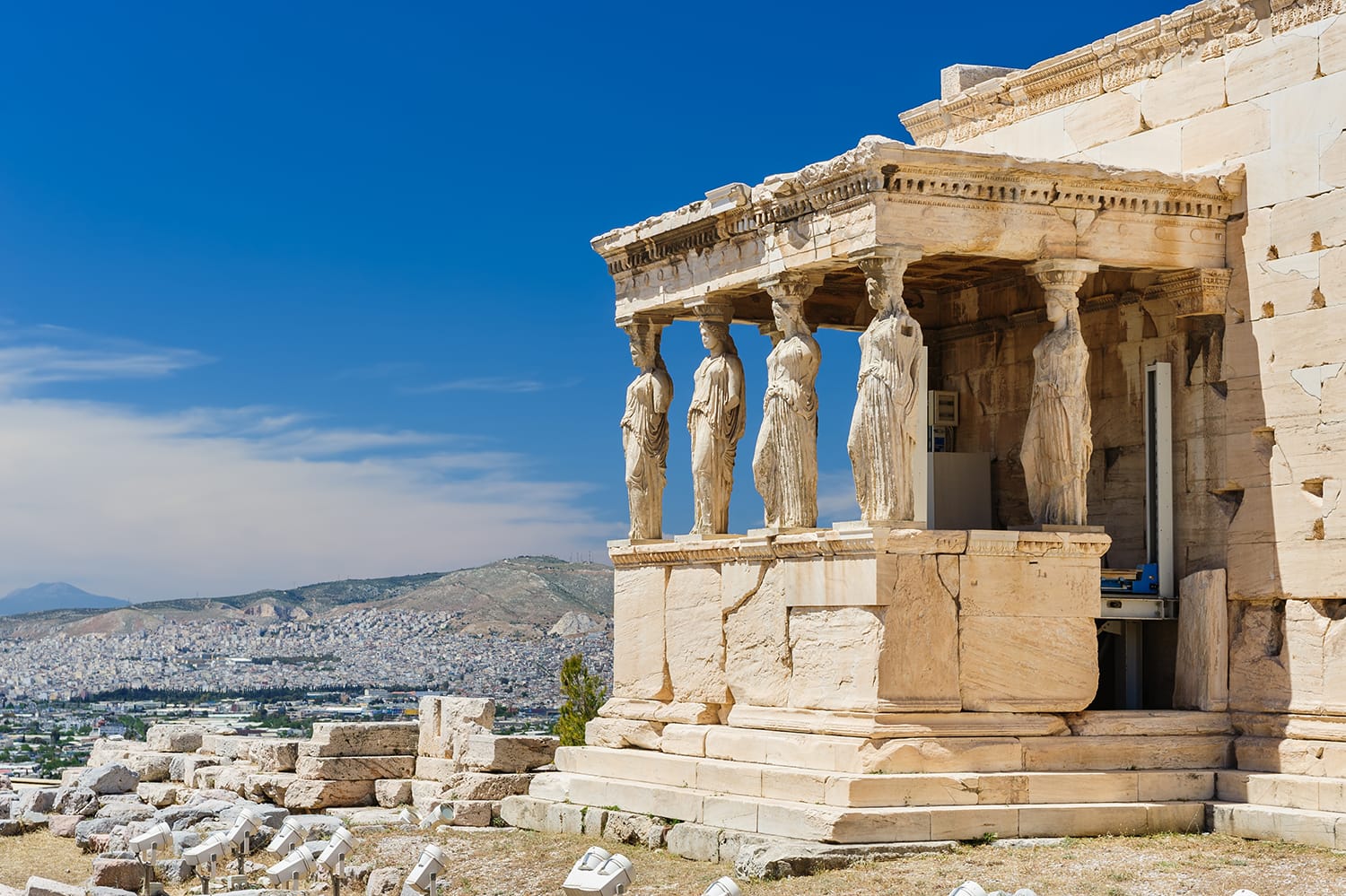
Useful Information for Visiting the Acropolis
Acropolis Hours of Operation
The Acropolis is open every day of the week but is closed January 1, March 25, May 1, Easter Sunday, December 25, and December 26. During summer, the site is open from 8:00 to 18:00 and during winter, it is open from 8:00 to 17:00. Last entry to the site is 30 minutes before closing time.
It’s important to understand that the Acropolis Museum has different opening hours to the site. From April 1 to October 31, the museum runs summer operating hours, opening at 8:00 and closing at 16:00 on Monday, 22:00 on Friday, and 20:00 the rest of the week. During the winter season, from November 1 to March 31, the museum opens at 9:00 and closes at 17:00 Monday to Thursday, 22:00 on Friday, and 20:00 Saturday and Sunday. Last entry to the museum is also 30 minutes before closing.
What’s the Best Time to Visit the Acropolis?
Since the Acropolis is a major tourist attraction in Athens, and one that’s mostly outdoors, it makes sense that there are better times to visit than others. No one wants to deal with huge crowds of tourists or bad weather that could possibly ruin what should be an unforgettable experience.
Athens and the Acropolis are at their busiest during the summer months of June through September. This means that this time of year is best avoided if you want to ditch the crowds. Instead consider visiting in April, May, and October when the crowds are a little lighter and the weather is still good. The winter months of November through March are best if you want the site at its quietest, but you will have to contend with colder weather and reduced daylight hours.
When visiting during the summer, the quietest times of the day to visit are first thing in the morning or in the late afternoon. This timing in summer works thanks to the longer days, the later opening hours, and the fact that you get to avoid the hottest part of the day this way. Going first thing in the morning also works in winter, although it isn’t quite as necessary.
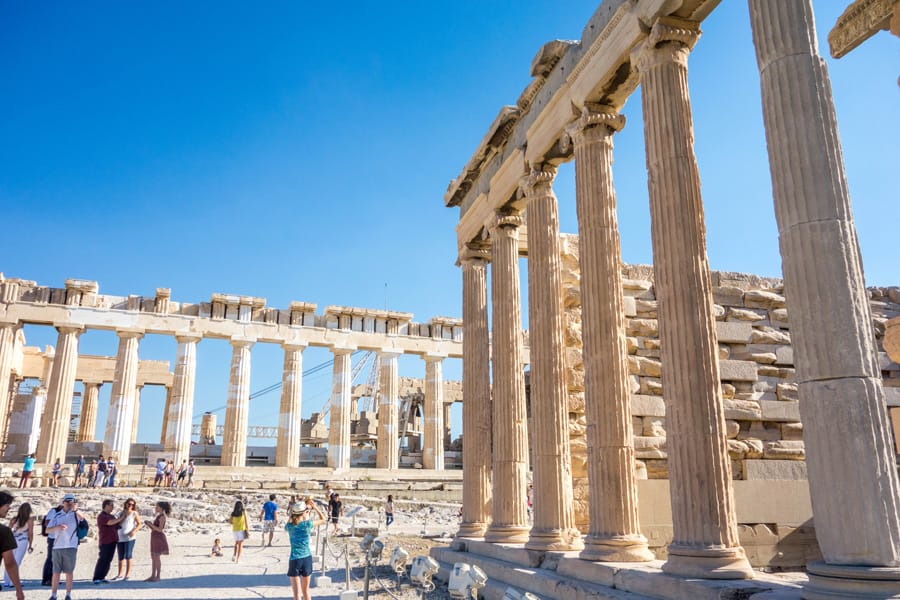
How to Get to the Acropolis
Getting to the temples at the Acropolis once in Athens shouldn’t be a problem as the site lies in the city center, close to many of the other popular things to do in Athens. Its hilltop also makes it very easy to find as the Acropolis is a defining feature of the Athens skyline.
The best way to reach the Acropolis will depend on where you’re coming from but typically involves taking public transport and then walking to one of the entrances. Single trip tickets for buses and the metro in Athens start at €1.40 for a 90-minute trip.
The two closest metro stations are the Acropoli and Monastiraki stations, with the Acropoli the closer of the two. From Acropoli station, it’s only one or two minutes on foot to the southeast entrance off Dionysiou Areopagitou Street. When coming from Monastiraki station, head south past the Roman Forum to Theorias Street and you’ll reach the western entrance in 10 to 15 minutes.
Tourists can also reach the western entrance by taking the 230 bus from Syntagma Square to the Akropolē bus stop and then walking for a few minutes.
How Do Acropolis Tickets Work?
When booking tickets for the Acropolis in Athens, it helps to know a few things about how the tickets work to get the most out of them. One of the most important things to understand is that tickets for the archaeological site and museum are separate, so you’ll need tickets for both if you want to visit both.
After purchasing tickets online for the Acropolis and its slopes, you’ll receive a voucher that you must take to a designated ticket office depending on which ticket you get. There you’ll exchange the voucher for your physical tickets. There are no time slots for Acropolis tickets, so you’re able to visit at any time on the day they are valid.

How Much Do Tickets for the Acropolis Cost?
The cost of tickets to the Acropolis depends on several factors, mainly related to the time of year, if you’re entitled to a discount, and whether it’s a single or combo ticket. During the high season, from April 1 to October 31, a regular single ticket costs €20 for adults, while from November 1 to March 31, the ticket’s price is reduced to €10. Combo tickets for adults cost €30.
Certain groups of visitors are able to get a single ticket at the reduced rate of €10 during high season. Those groups include citizens of the EU over 65 and youths aged 6 to 25. EU citizens aged 25 and under are entitled to free entry into the Acropolis, as is any child aged 5 and under of any nationality.
There are also days throughout the year where admission to the Acropolis is free to the public. These days include the first Sunday of the month from November to the end of March, March 6, April 18, May 18, October 28, and the last weekend of September.
Hotels Near the Acropolis in Athens
Thanks to its central location in Athens close to popular neighborhoods like Plaka, Monastiraki, and Psirri, visitors will find lots of places to stay close to the Acropolis. So, if staying near the Acropolis – or even having a view of it – is a priority, then you’re in luck. If you don’t feel like navigating a long list of accommodation options, allow us to suggest a few places to make things easier.
For the perfect combination of style and location, treat yourself to a stay at the AthensWas Design Hotel. Perfectly located one minute from the southeast entrance, this five-star design hotel boasts spectacular views of the Acropolis and a striking, modern décor.
There’s no secret to what’s waiting for you at the affordable yet comfortable Acropolis View Hotel. This three-star hotel is a five-minute walk from the western entrance and offers some rooms with private balcony views of the Acropolis as well as a superb view from its rooftop terrace.
Finally, we have good news for budget travelers. Not only is Athens Studios one of the best hostels in Athens with dorms and private apartments available, it’s located just two minutes from the Acropoli metro station and Acropolis Museum.
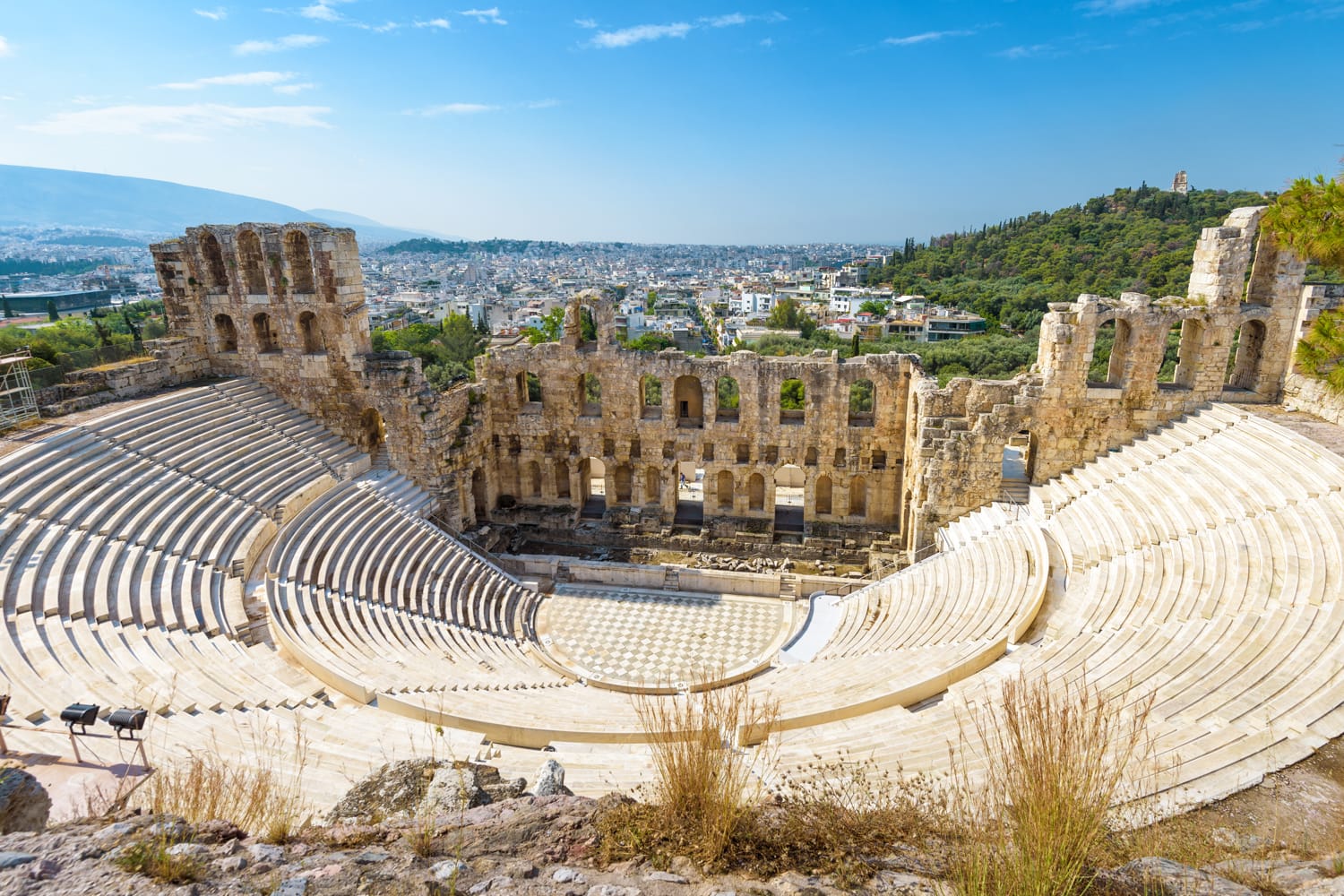
Security Process at the Acropolis
As with any special historical site or tourist attraction, entry to the Acropolis means following various security procedures to be granted entry. This means that even if you do skip the line for purchasing tickets to the Acropolis, you may need to wait in a shorter line to pass through security at the entrance. Realistically, though, this process is much less involved than other world-famous attractions.
Visitors are permitted to bring small backpacks and handbags into the site, as well as photography equipment. However, drones are not permitted over archaeological sites in Greece. It’s best to store large luggage at a hotel or with a luggage service as it’s not possible to store these items at the site. Similarly, while you’re able to store small bags at the Acropolis Museum cloakroom, it’s not practical to bring large bags there either.
Due to the pandemic, visitors to the Acropolis must follow government protocols related to COVID-19. This involves showing proof that they have either been vaccinated or proof that they have recovered from the virus. Minors ages 4 to 17 can instead provide a negative test.
Visiting the Acropolis with a Disability
An understandable concern for some visitors to the Acropolis is how accessible the hilltop archaeological site is for visitors with disabilities. The good news is that amenities have been introduced in recent years to make the site better suited to people in wheelchairs or with mobility issues.
Flat pathways around the site have been introduced to allow access via wheelchair, and there is also a designated elevator up to the top, located 350 meters (1,148 feet) from the western entrance. Make sure to contact the site in advance to ensure access by calling +30 210 3214172.
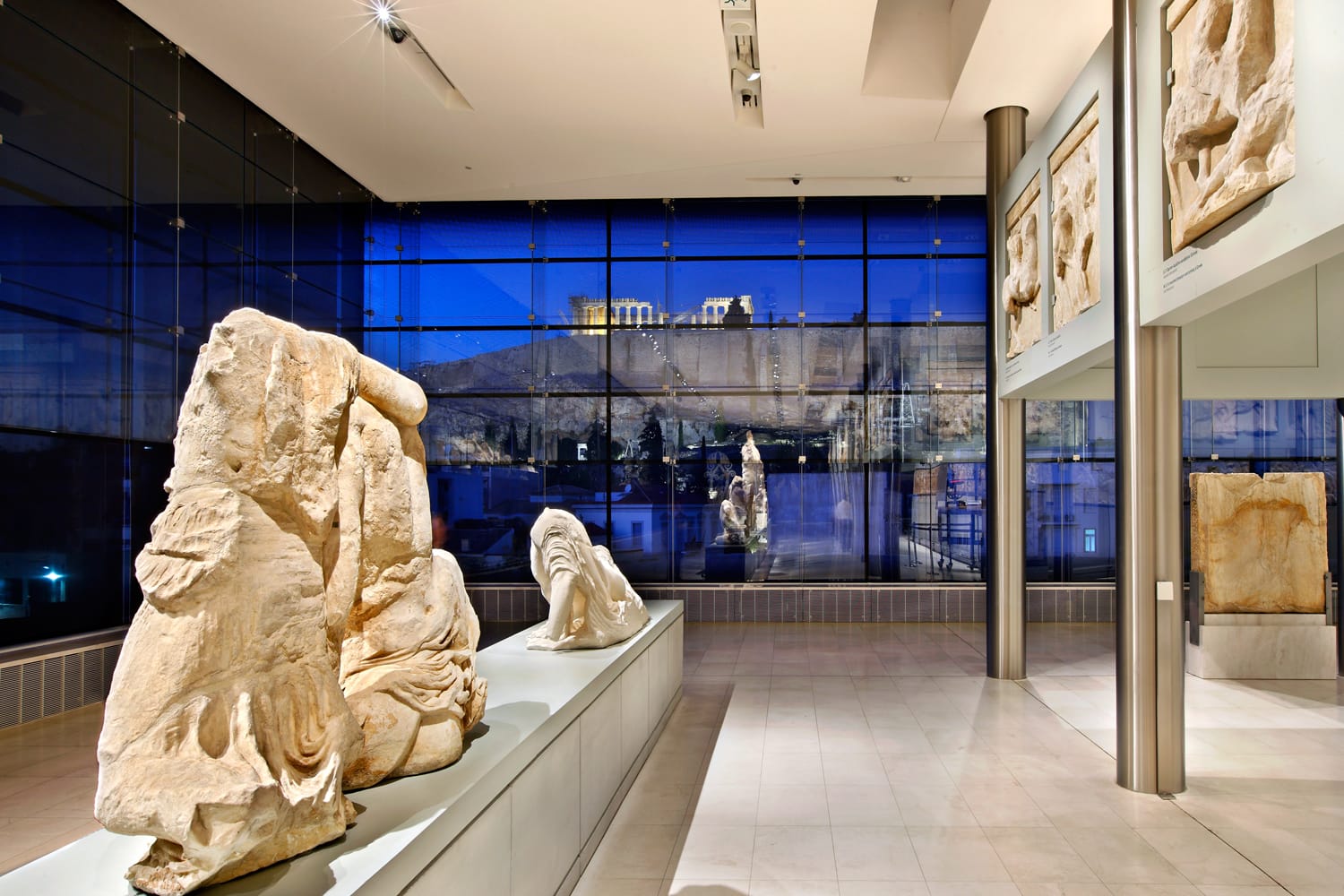
FAQ – Facts About the Acropolis
What is the Acropolis in Athens?
The Acropolis is a citadel on a rocky hill, inside of which are several ancient temples still standing today, such as the Parthenon.
What Does Acropolis mean?
The word acropolis literally means a city at the highest point and was a common term for an ancient Greek citadel built on a hill in a city.
When Was the Acropolis Built?
The Acropolis and many of its main landmarks were built during the fifth century BCE.
How Old is the Acropolis?
The oldest significant parts of the Acropolis are roughly 2,500 years old.
Who Built the Acropolis?
Pericles was the politician responsible for the construction of many of the main surviving landmarks at the Acropolis.
Why Was the Acropolis Built?
The temples of the Acropolis were built to worship various gods of Ancient Greece and required rebuilding after the Persians invaded in the fifth century BCE.
Where Is the Acropolis Located?
The Acropolis is located on a limestone hill that shares its name in central Athens, the capital of Greece.
Hopefully that answers all your questions about the history of the Acropolis while also telling you what you need to know before visiting and the best ways to get your Acropolis tickets. Having all this information in advance is sure to make planning your visit a whole lot quicker and easier.

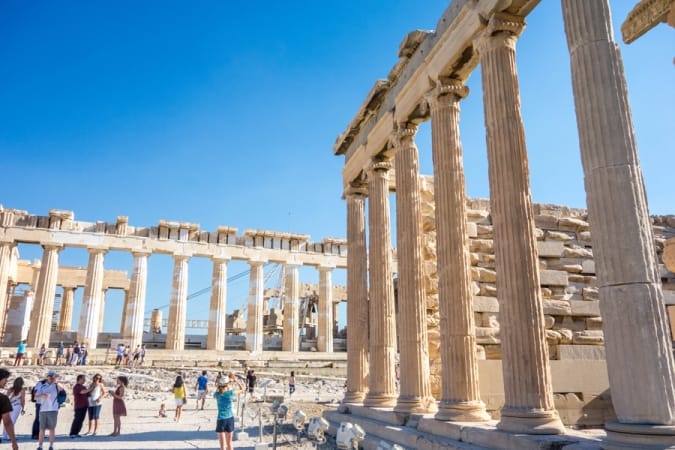






Comments